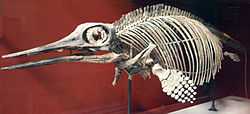Ophthalmosaurinae
| Ophthalmosaurinae Temporal range: Middle Jurassic-Early Cretaceous, 171.6–99.6Ma | |
|---|---|
 | |
| Ophthalmosaurus icenicus skeleton | |
| Scientific classification | |
| Kingdom: | Animalia |
| Phylum: | Chordata |
| Class: | Reptilia |
| Order: | †Ichthyosauria |
| Family: | †Ophthalmosauridae |
| Subfamily: | †Ophthalmosaurinae Baur, 1887 |
Ophthalmosaurinae is an extinct subfamily of ophthalmosaurid thunnosaur ichthyosaurs from the Middle Jurassic to the late Early Cretaceous (Bajocian - Albian) of Europe, North America and South America. Currently, the oldest and the basalmost known ophthalmosaurine is Mollesaurus from the early Bajocian of Argentina. Ophthalmosaurines were characterized by a large extracondylar area of the basioccipital in form of a thick and concave peripheral band, posterodistally deflected ulnar facet of the humerus, large ulna with concave and edgy posterior surface and ischiopubis with obturator foramen.[1]
Phylogeny

Ophthalmosaurinae was named in 1887 by George H. Baur. It is a stem-based taxon defined phylogenetically for the first time by Fischer et al. (2012) as "all taxa closer to Ophthalmosaurus icenicus than to Platypterygius hercynicus". The cladogram below follows Fischer et al. 2012.[1]
| Ophthalmosauridae |
| ||||||||||||||||||||||||||||||
| |
References
- ↑ 1.0 1.1 Valentin Fischer, Michael W. Maisch, Darren Naish, Ralf Kosma, Jeff Liston, Ulrich Joger, Fritz J. Krüger, Judith Pardo Pérez, Jessica Tainsh and Robert M. Appleby (2012). "New Ophthalmosaurid Ichthyosaurs from the European Lower Cretaceous Demonstrate Extensive Ichthyosaur Survival across the Jurassic–Cretaceous Boundary". PLoS ONE 7 (1): e29234. doi:10.1371/journal.pone.0029234.